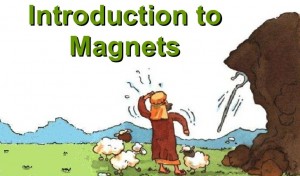Ever hear the story of the magic stones found by a shepherd boy, in ancient Greece (some say Turkey)? The story is recounted by the Roman historian, Pliny, about a young boy, named Magnus, who wore iron-tipped sandals and had iron in the crook of his shepherd’s staff. Wandering the hills of Mount Ida, he noticed some stones were hanging onto the bits of iron that he wore. These bits of stones were natural magnets (Magnus is forever immortalized in the name of the mysterious stones).
PUTTING THE MYSTERIOUS STONES TO TO WORK
It seems like it was the Chinese put natural magnets to work. They found that if they floated a bit of magnet on a little raft, in a bowl of water, it would turn to point to the north. Marco Polo is said to have carried a compass with him back to Italy after his journey to China in the 1200’s. In the 1500s, Dr. William Gilbert of England figured out that the compass works because the earth is a giant magnet, and the North Pole of the earth pulls the opposite pole on every compass magnet.
You have to imagine that all of this seemed rather weird to those that first started working with magnets. And it was weird – to a certain extent, magnets still are weird. But something as mysterious, powerful, and defiant of understanding (at the time) as a magnet just begged for them to be employed in another area of great mystery: the human body.
MESMERIZED
The idea that magnets were somehow therapeutic seems to have begun in the early 16th century, with the Swiss physician, philosopher, and alchemist, Paracelsus (he was most notable for founding the field of toxicology, and naming zinc, among other accomplishments – you can read about him if you CLICK HERE). By the mid-18th century, the popularity of magnetic therapy increased, thanks largely to the Austrian doctor Franz Mesmer (whose name gave rise to the word “mesmerize”). Dr. Mesmer used his magnets to treat people’s innate “animal magnetism” and gained fame an fortune treating people in Paris (after being forced to leave Vienna after unsuccessfully treating an 18 year old woman for blindness). Magnetism was not understood, and neither was disease; might as well use one strange thing to treat another!
Foreshadowing today, Mesmer’s treatments split people into two camps. There were those who thought that he as an absolute quack, and those who resolutely believed in his treatments, no matter what anybody else said (sound familiar?). Interestingly, leading the charge of the intense scientific criticism – and testing – that hounded Mesmer was none other than the esteemed Benjamin Franklin. But, like today, basic science and established facts did little to stem the magnetic tide, at least for a time.
MAGNETIC TRACTORS
It’s an absolute truth that, when it comes to quackery, there are almost limitless opportunities, spanning not only time, but species, as well. Thus, at least by the end of the 18th century, magnets were being applied to horses. Elisha Perkins, a Connecticut doctor and mule trader, applied his “magnetic tractors” (little magnetic wedges) to “draw off the noxious electrical fluid that lay at the foot of suffering.” Testimonials followed, and Dr. Perkins also became very rich. Medical quackery may be ridiculous, but it’s often lucrative.
Magnets seem to have taken something of a pause, therapy-wise, in the early 20th century, but by the 1980’s or so, they were back in (magnetic) force, being applied in the form of boots, and blankets, and even horseshoe pads. I remember when they hit the market, too, and I was really curious what the fuss was about. I mean, even though I did a science fair project in 8th grade on magnets (honorable mention, thank you very much), for the life of me, I couldn’t figure out why in the world people might want to strap magnets to a horse. So I figured I’d try to find out.
LOOKING INTO THE CLAIMS – INCREASING CIRCULATION
Working with, among other folks, a well-known scientist at Cal Tech, where some of the smartest people on the planet like to do incomprehensible experiments for fun, I looked into magnets, and their effects on the body, and, in 1989 (as I recall), I published a really long article about them. It’s still on-line, and, if you have the time or inclination, you can read it if you CLICK HERE.
So, from what I can tell, the reason to use magnets on horses has something to do with improving or increasing the circulation, which is then supposed to help everything heal up faster/better/whatever. This canard is one that seems to be used to support just about every therapy known to man, bogus or otherwise, but in the case of magnets, the claim is really pretty odd, if for no other reason than it’s been so roundly and frequently disproven.
I guess that the claim isn’t completely stupid, at least when you think about it. I mean, blood does contain iron, in the form of hemoglobin, the pigment that makes blood red (and more importantly, carries oxygen), and iron is attracted to magnets. But blood isn’t attracted to magnets – in fact, that was shown by the two time Nobel Prize winning scientist Linus Pauling way back in the 1930’s (interestingly, he’s also responsible for promoting the now disproven claim that vitamin C was a cancer – well, pretty much everything – cure). In fact, if blood were attracted to
magnets, magnetic fields wouldn’t improve circulation, rather, they’d cause a big clump at the area where the magnet was applied. And heaven forbid if your horse (or you, for that matter) ever had to have an MRI. Your horse would blow up, as it were, what with all of the blood cells being pulled right out of his body.
But never fear, the magnets used in magnetic boots and blankets are too weak to penetrate the thick skin of a horse. You show that with your own magnetic boots or blankets (if you own them) – try sticking a paper clip to the magnet if you put a sock (or something similarly thick) between the magnetic wrap and, say, a paper clip. If the clip won’t stick, it’s because there’s no magnetic field there.
Study after study in a variety of species have shown that magnets to nothing to or for blood circulation. In horses, there was one done by a group at Colorado State University (including me) in 2000 (CLICK HERE), and one in 2014, done in Sweden, showing no effects of a magnetic blanket on blood flow, behavior, muscle tension, or pain threshold (CLICK HERE). The list of publications showing no effect is virtually unanimous.
:LOOKING INTO THE CLAIMS – HOW ‘BOUT THOSE IONS?
 “OK,” magnetoenthusists may say, “What about all of those ions? What about the fact that magnets affect charged particles?” And, in fact, the horse’s body if full of ions.
“OK,” magnetoenthusists may say, “What about all of those ions? What about the fact that magnets affect charged particles?” And, in fact, the horse’s body if full of ions.
But, here, too: no, just no. You see, magnets don’t attract or repel ions, even though, under certain conditions, they can make ions move. In order to do this, however, the ions themselves have to be moving, and they have to be moving at a 90 degree angle to the magnetic field. And that means that most of the body’s ions – the ones that aren’t moving, or the ones that aren’t perfectly lined up – can’t be affected at all. But even when it does occur, the effect on moving ions is minuscule, and it takes a super strong magnet – think MRI – to even be able to detect such a change. The cute little magnets they sew into blankets don’t do anything at all. And this goes for pulsating electromagnetic fields (a different, but just as implausible treatment), too.
 But let’s just say that you want to ignore all those facts, and you want to sit back and imagine that magnets actually do affect your horse’s ions. The problem here is that if a magnet worked in this way, it would work on every single cell in your horse’s body. And in bouncing all of these ions around, what the magnet would be doing would not be healing; it would be screwing up the function of essentially every cell in the horse’s body. Ion-dependent cellular processes – say, nerve transmission, or muscle function – would break down. The magnetic field would affect every ion, not just bad ones (whatever that might mean). The problems caused by indiscriminate ionic movement would be catastrophic to the poor horse.
But let’s just say that you want to ignore all those facts, and you want to sit back and imagine that magnets actually do affect your horse’s ions. The problem here is that if a magnet worked in this way, it would work on every single cell in your horse’s body. And in bouncing all of these ions around, what the magnet would be doing would not be healing; it would be screwing up the function of essentially every cell in the horse’s body. Ion-dependent cellular processes – say, nerve transmission, or muscle function – would break down. The magnetic field would affect every ion, not just bad ones (whatever that might mean). The problems caused by indiscriminate ionic movement would be catastrophic to the poor horse.
MAYBE FOR PAIN RELIEF, AT LEAST? PLEASE?
So, if it doesn’t help with circulation, what about pain relief? Well, not there, either. Even the United States National Center for Complementary and Integrative Health, an organization that seems to have bent over to find some support for some pretty silly therapies over the years says, “Scientific evidence does not support the use of magnets for pain relief.” CLICK HERE and see for yourself.
PULSATING ELECTROMAGNETIC FIELDS – DO THEY MAKE YOUR HEART THROB?
So what about pulsating electromagnetic fields, those expensive systems that have blankets or boots that hook up to a machine that generates an electromagnetic field. These are a little different, that is, they aren’t absolutely and completely implausible (that’s not really a compliment), because electromagnetic fields can induce an electrical current in the area surrounded by the magnetic field (it’s a physics thing, discovered by the English physicist Michael Faraday back in 1831). And, in fact, they have been used for the treatment of non-union fractures in people (non-union fractures are ones that should, but don’t seem to want to, heal), although the medical literature seems to have cooled off a bit for that use.
Sellers say that the devices decrease pain, but it’s anyone’s guess how that might happen. For sure they don’t slow down nervous impulses – it takes a magnetic field stronger than has ever been produced to slow nerve conduction by just 10%. Add in that nobody has any idea what, if any setting or intensity produces any particular desired effect, and you’re just left scratching your head. All of the other testimonials that you see – for performance, healing, pain, or whatever – simply aren’t supported by any solid evidence… just like Mesmer, 300 years ago.
ZOMBIE APOCALYPSE
Magnetic therapy is sort of like zombie medicine, when you think about it. It never dies, and no one seems to be able to kill it. The arguments for it don’t make any sense, and there’s an overwhelming amount of scientific evidence that shows that they really don’t do anything, therapy-wise. But on it lurches, arms out, waiting to reach deep into the wallets of the next unsuspecting human/horse owner.
But there is good news, especially if you’ve bought a magnetic boot or blanket. You can always cut them up, take out the magnets, and use them to hold up notes or photos on your refrigerator. Every cloud has a silver lining.















